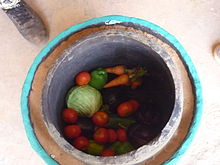Clay jug cooler
The clay jug cooler (also known as a pot in pot refrigerator or desert refrigerator ) is a simple and inexpensive way to cool food, especially vegetables and fruits.
The cooling function is based on the principle of evaporation and does not require electricity. The cooling effect is greatest in dry and hot climates. These conditions can be found, for example, in a wide area from West to East Africa, in which large parts of the population have no opportunity to refrigerate food. With this cooling system, in hot and dry climates such as in Burkina Faso, even with outside temperatures of over 40 ° C, internal temperatures between 13 and 22 ° C are achieved. With the clay jug cooler, food can be kept many times longer than when it is stored without refrigeration.
Working principle
The basis for cooling with the clay jug cooler is the principle of evaporative cooling: the evaporation of water requires energy that is extracted from the ambient air in the form of thermal energy, which leads to a lowering of the air temperature .
The clay jug cooler uses this principle through a relatively simple construction of two clay jugs and sand . A small clay jug is placed in a large clay jug and the space in between is filled with coarse sand. The sand in the space is watered and the clay jug cooler is closed with a damp cloth or lid. Due to the porosity of fired clay, the water can diffuse through the clay jug and evaporate on the outside of the large clay jug. This removes energy from the inside of the small clay jug and thus lowers the temperature.
history
The clay jug cooler was invented in the 1990s by the Nigerian university professor Mohammed Bah Abba, who comes from a pottery family in northern Nigeria. However, this principle was already known to the ancient Greeks. Abba's organization, Mobah Rural Horizon, had already put over 100,000 clay jug coolers into circulation in northern Nigeria by 2010 (Oluwasola / UNDP: 2011). Since the use of the clay jug cooler has a number of positive effects, the idea of this cooling option has already been taken up by some organizations in other countries. B. Practical Action in Sudan , Humanity First in Gambia and Movement e. V. in Burkina Faso .
Positive effects by using the clay jug cooler

The use of the clay jug cooler is associated with a whole range of positive effects that can bring benefits to everyone involved along the value chain:
- Increasing food security through the extended life of foods and avoiding food waste .
- Financial and time savings for the user through less shopping and less food waste.
- Work for local potters who make the clay jugs with local materials.
- The hard work involved in making ordinary clay jugs brings very little returns. Depending on the design of the business model, the production of clay jugs for the clay jug cooler can contribute to an increase in income in the pottery families.
- Avoidance of illness by eating inedible foods
- Longer shelf life of products slows down the fall in prices of fruit and vegetables and thus increases the income of vegetable sellers.
- Increased flexibility in terms of time when selling groceries, which, when it is widespread, such as in northern Nigeria, led to a higher rate of school attendance among the often underage vegetable sellers.
Individual evidence
- ↑ Archived copy ( Memento of the original from July 14, 2014 in the Internet Archive ) Info: The archive link was inserted automatically and has not yet been checked. Please check the original and archive link according to the instructions and then remove this notice.
literature
- Oluwemimo Oluwasola: Pot-in-pot Enterprise: Fridge for the Poor . United Nations Development Program, New York 2011 ( online [PDF]).
- Peter Rinker: The clay jug cooler - an adapted cooling option . Construction and usage instructions. Movement eV, Teningen June 2014 ( movement-verein.org [PDF]).

